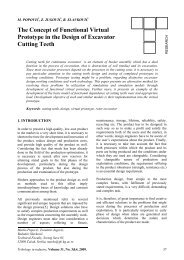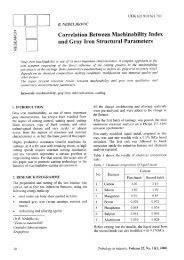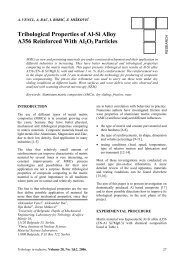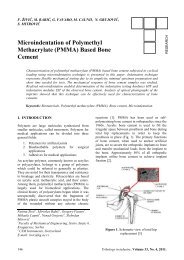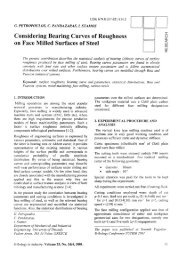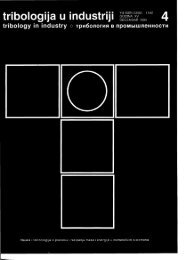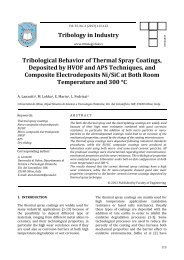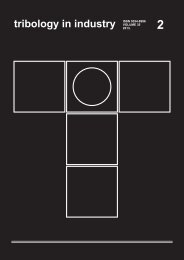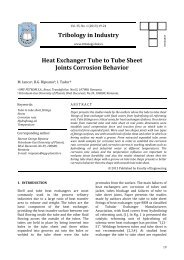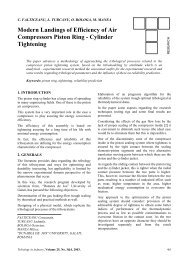No. 1, 1998 - Tribology in Industry
No. 1, 1998 - Tribology in Industry
No. 1, 1998 - Tribology in Industry
You also want an ePaper? Increase the reach of your titles
YUMPU automatically turns print PDFs into web optimized ePapers that Google loves.
30,0<br />
FcL<br />
25,0<br />
t25<br />
A. P= 01,/Po<br />
_,1 -e- P= 1900 MPc]<br />
_EF p- 3300l4pci<br />
_o,. p= 4700 t1p0<br />
0,2 0,3 0,1,<br />
_* h (mnr)<br />
Fig.4. Depetdence of 8211 ott lr<br />
as relative residual austenite; this fact can expla<strong>in</strong>ed by<br />
appearance of high temperatures <strong>in</strong>ner surface layer<br />
which have various values at different depths; the correlation<br />
between the two sizes displays transformations of<br />
type Fea(TBC) - Fca(BCC) and Fey - Fea(BCC) or<br />
Fea(TBC);<br />
c) the size .8277 strongly varies up to 200 prre <strong>in</strong>side the<br />
surface Iayer and it follows a stabilization.<br />
In figure 5 is displayed the dependence of size<br />
8226-oflh). From presented data results: the <strong>in</strong>ner second<br />
order tensions have a peak between 100-200 pm<br />
depth, while the cuwes IJ2ao = Bzzo&) are alternately<br />
placed for the three values of the pressure P. This can be<br />
accounted for by changes of the prevail<strong>in</strong>g mechanical<br />
and thermal effects at variorrs depths dur<strong>in</strong>g pitt<strong>in</strong>g tests.<br />
Fig. 5. Dependcnce of B2x1 ort h<br />
In figure 6 it is presentecl the evolution on surface layer<br />
depth of the size (l,,rirlt,or)22a. The shapes of designed<br />
cun'es are similar for the three pressures. At P=0 MPa<br />
maximum of dislocations density is located at a depth of<br />
3001.un<br />
<strong>in</strong>side the surtace layer. At pressure of 1900 MPa<br />
8<br />
ll, a<br />
l?i,,<br />
oq<br />
nfl<br />
0,7<br />
0,rl<br />
I<br />
f<br />
z\- p=rl j,4po<br />
C) '.f',.'1900 lt,lPa<br />
{.t P- 3300 I'll"ci<br />
l- P =1, i 0C lv1 Ptt<br />
|<br />
0,1<br />
|<br />
0,2<br />
- i--<br />
0,3<br />
Fig" 6. Dt:ptndrnce af (l,rullrnut)220 ort lt<br />
is found a decrease of the general dislocations density<br />
level. The maximuln of this cun'e is situated near sut{ace<br />
of the sur{ace lrryer. For 1' = ,}300 tr[Pa zrnd I'>:4700 MPa<br />
the maxima of curyes remove <strong>in</strong>ner of the surface layer,<br />
hav<strong>in</strong>g the same values ancl are located <strong>in</strong> the sarne area<br />
approximately. This fact shorvs that the anneal<strong>in</strong>g thermal<br />
treatment is not enough or should be performed by<br />
an another diagram <strong>in</strong> orcler to reduce the level of the<br />
dislocations density.<br />
6. CONCLUSIONS<br />
1+-- _<br />
J).,1:iii<br />
l. lr<br />
() /, al r,<br />
-t<br />
> Us<strong>in</strong>g the concepts of the tribosystem, tribomodel,<br />
triboelement and surface layer it was possible to prepare<br />
a pitt<strong>in</strong>g test<strong>in</strong>g program <strong>in</strong> order to establish the<br />
tribological behavior of case-harden<strong>in</strong>g steel 21<br />
MoMnCrl2XS recommended for replac<strong>in</strong>g the bear<strong>in</strong>g-roll<strong>in</strong>g<br />
steel RUL-1,<br />
> From the clistribution on the surfac:e layer depth of the<br />
structural changes IXS=XS&) andX5:y511't)] - dist<strong>in</strong>guished<br />
by X-ray diffraction nrethod-the follorv<strong>in</strong>g<br />
conclusions can be drawn:<br />
a) the existence - <strong>in</strong> <strong>in</strong>ner of the surface layer of the<br />
case-harden<strong>in</strong>g steel - of the diference behveen mechanical<br />
and therrral effects which develop clur<strong>in</strong>g<br />
pitt<strong>in</strong>g test; this fact is consiclered as a negative factor<br />
on the structural and d<strong>in</strong>rensionul .stabilities<br />
b) the existence on surflce layer depth of a nonhomogeneity<br />
fol <strong>in</strong>ner secontl order tensious which, at<br />
ctepth of 100-2001trn, has a naximum value; this fact<br />
shows that it is possible that sorne microcracks appear<br />
<strong>in</strong> this area<br />
c) the existenc:e of a contact pressure limit which the<br />
case-harden<strong>in</strong>g steel can be stressed; a higher pressure<br />
(over the nrentioned iimit) can Iead to appearance of<br />
-some phase transformations (e. g. Fea*Fey) which<br />
are not recr.rmrnencleci for case-hurden<strong>in</strong>u steel.<br />
Ii'ibologt irt itultts'try, \blume 20, <strong>No</strong>. 1, <strong>1998</strong>.<br />
)



